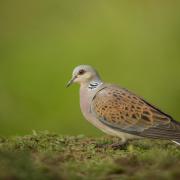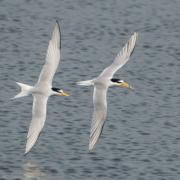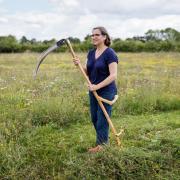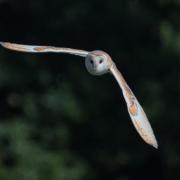Minsmere nature reserve, on the Suffolk coast, is one of the richest wildlife sites in Eastern England, home to rare birds, mammals, butterflies, plants and other creatures great and small. The RSPB’s Diane Church explores its highlights and its environmental importance

With so much of the Suffolk coast being an Area of Outstanding Natural Beauty, there is always a wealth of natural spectacles to behold in our beautiful county. Yet nowhere are the sights more impressive or the wildlife more accessible than at the RSPB’s nature reserve at Minsmere.
Nestled between the cliffs of Dunwich to the north and Sizewell to the south, and looking out onto the North Sea, Minsmere is a wonderful place to get closer to nature at any time of year – whether you are a seasoned birder, you want to blow away a few cobwebs, or you’re struggling to find ways to entertain the kids.
An astonishing 5,600 species have been recorded at Minsmere over the years, ranging from red deer – our largest native land mammal in the UK – to the rather amusingly, but appropriately, named pantaloon bee – the females’ hind legs have oversized orange pollen brushes which make it look as though they are wearing trousers.

The reserve is a vital breeding, roosting and feeding site for more than 100 resident species of birds and an additional 240 migratory visitors each year. Add to that 1,000 species of butterfly and moth and you are still only scraping the surface of Minsmere’s array of flora and fauna.
Minsmere owes its treasure trove of natural wonders to the fact that it encompasses four of the nation’s key conservation habitats to be found in lowland England – reed beds, wet grassland, shingle vegetation and lowland heath.
Together with woodland and a long stretch of beach, each of these diverse habitats is home to its own uniquely specialised array of native species, creating a reserve of extraordinary biodiversity.

Yet if it hadn’t been for a fortuitous decision made by a local army captain during the Second World War, the reserve may never have come in to existence.
In the 1940s, the gates on the Minsmere sluice were opened and the low-lying marshes and farmland were flooded to provide protection against a possible German invasion.
Whatever the merits of the manoeuvre as a wartime defence plan, the flooding proved successful in attracting avocets to the site and in 1947 these elegant black and white wading birds nested in Britain for the first time in over 100 years.

The same year, the RSPB signed an agreement to take over management of the site and the rest, as they say, is history.
Since then, the number of avocets has increased steadily across the UK and today around half of the UK’s breeding avocets nest on RSPB nature reserves.
In recognition of this success the avocet was adopted as the charity’s emblem and to this day appears on the RSPB’s logo, immortalising this once extinct British breeding bird as a symbol of wildlife conservation.

Other crucial conservation successes at Minsmere have included marsh harriers – the largest of the harriers – and the ‘booming’ bittern, a shy rounded heron.
Both were perilously close to becoming extinct in the UK due to habitat loss and persecution, but can now be heard and seen regularly at Minsmere where they’ve made their home.
Nine pairs of marsh harrier bred at the reserve last year and Minsmere is probably the best place in the UK to see bitterns, often feeding just a few metres away from the Island Mere and Bittern hides in winter.

Visiting Minsmere
To get the most from Minsmere, start at the visitor centre to find out about the latest activities and wildlife sightings. Families with young children will want to visit the Wild Zone with its den-building and climbing activities or take a stroll along one of the reserve’s wheelchair and buggy-friendly paths.
For those looking to stretch their legs a bit more, there are many miles of footpaths and trails and the spacious wildlife-watching hides offer excellent views of seasonal spectacles throughout the year.

With spring approaching, snowdrops, daffodils and primroses are already bursting from between the fallen leaves in the woodlands. The song of wrens and the drumming of woodpeckers are growing louder as the days lengthen, soon to be joined by warblers such as chiffchaffs and whitethroats.
If you’re really lucky, you may even catch sight of the reserve’s superstar nightingales when they return to our shores or you may spot an otter, adder, lizards or water voles.
With so many species and so many habitats, there is always something to see at Minsmere - every season of the year.
In late June, the first spotted redshanks, ruffs and other wading birds will begin to return from the Arctic and the heaths will be transformed to a stunning purple as the heather begins to flower. Summer evenings bring nightjars churring at dusk, and you may spot a glow-worm too.
Whatever time of year you choose to visit, it is inevitable that you will find your very own reasons to love Minsmere. If you are a regular visitor or RSPB member, you no doubt already have your own special moments and cherished memories.
So make the most of this very special Suffolk treasure, we’re very fortunate to have such a spectacular natural haven on our doorstep.
The RSPB would love to hear why you love Minsmere. You can share your highlights on Twitter @RSPBMinsmere, using #LoveMinsmere, or on the RSPBSuffolk page.
For further details about visiting Minsmere, go to rspb.org.uk/minsmere or call 01728 648281.
Until March 29, 2019, EDF Energy is consulting on its plans for a new nuclear power plant to be built at Sizewell C, next to the southern edge on Minsmere nature reserve.
This development has potential to cause significant harm to Minsmere’s precious habitats and wildlife, if EDF fails to ensure that its plans keep Minsmere safe. The RSPB is therefore asking people to tell EDF that Minsmere must be protected from harm.
If you’d like to add your voice to the RSPB’s call for EDF to protect this special place you can do so online at loveminsmere.org



























